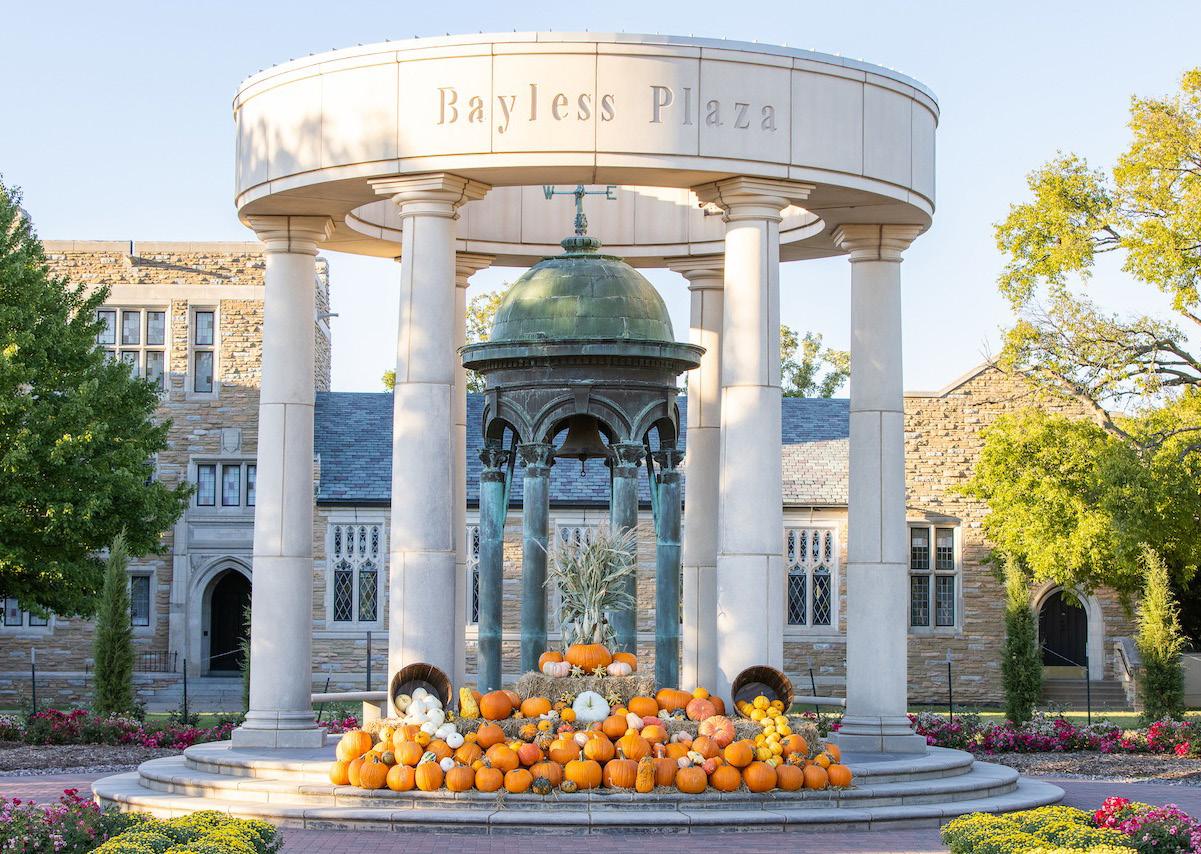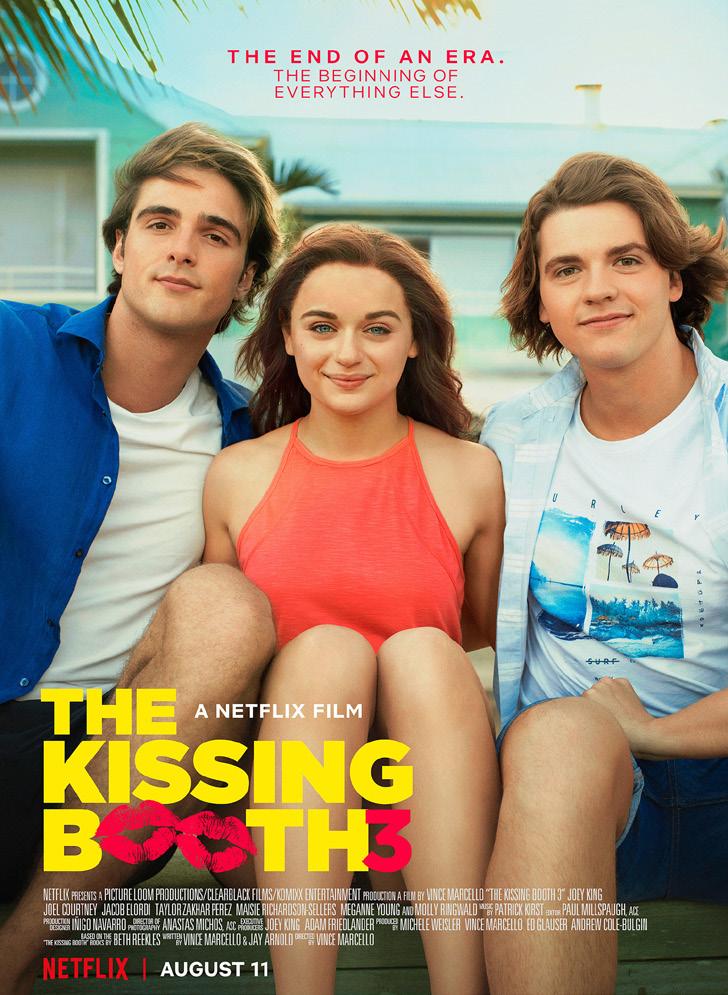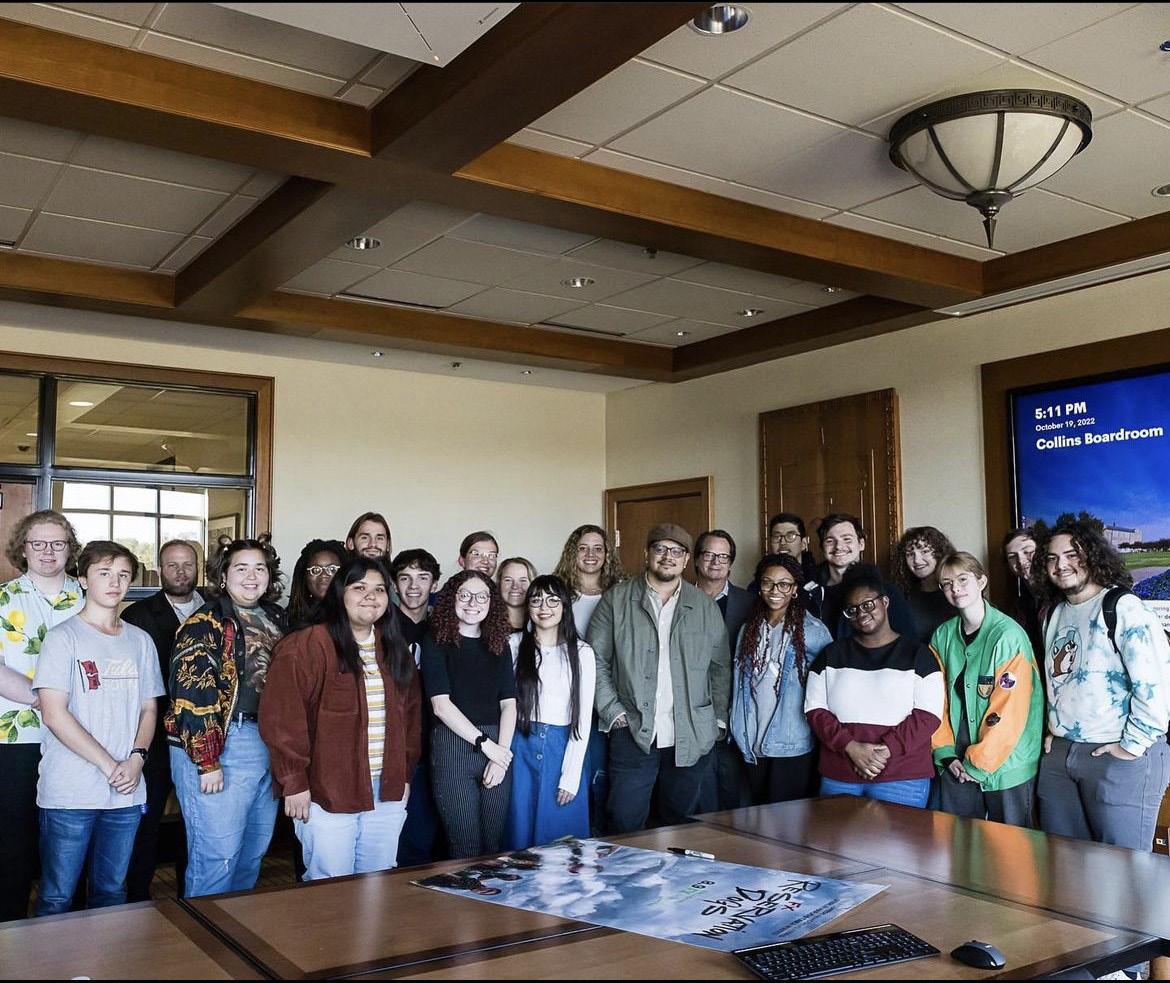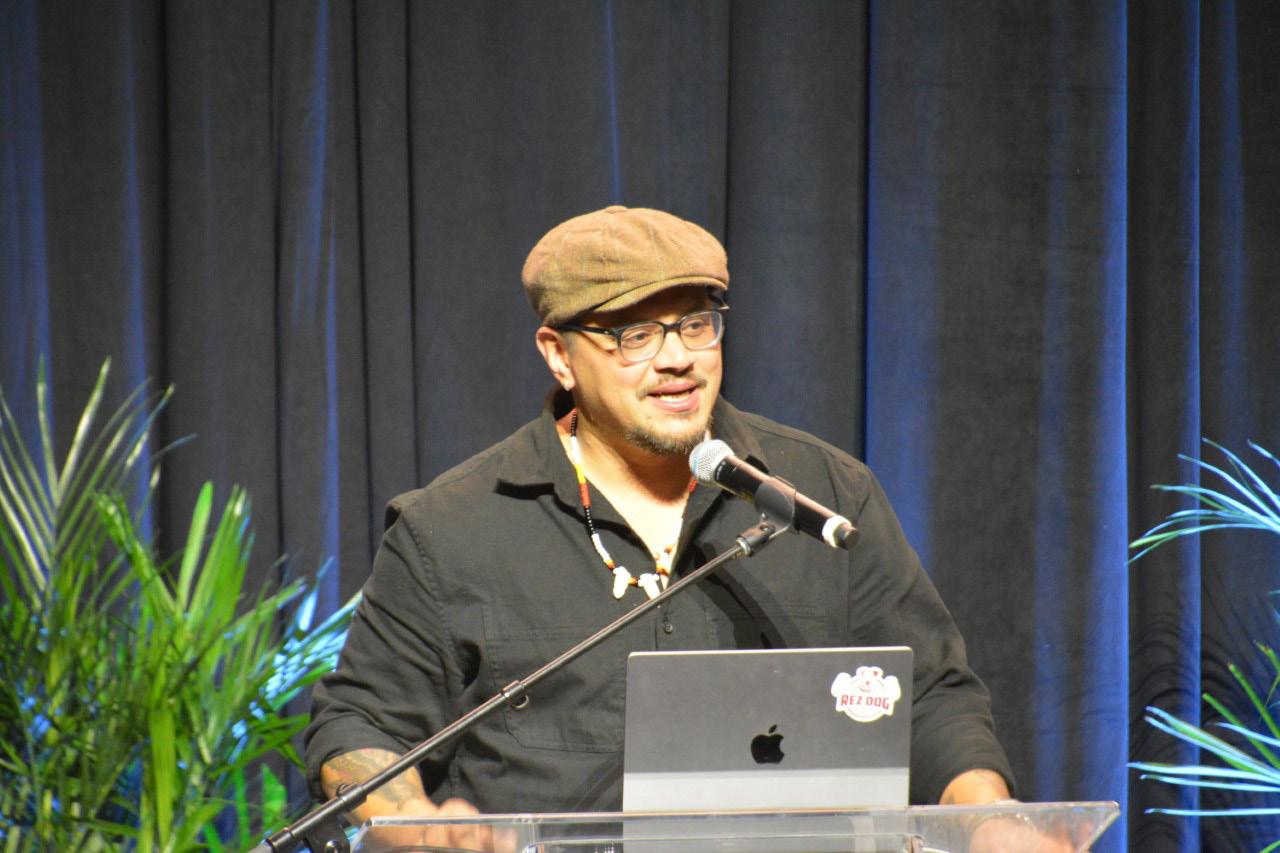





While not matching the results of last year’s 16-2-1season, Tulsa men’s soccer has quietly performed at a level that has gotten national recognition, both at the in dividual and collective level, with many Tulsa players gaining NCAA honors on top of consistently ranking in the top 25 eight of the last nine weeks.
Beginning the season as the favor ites to win the American Athletic Con ference for the second straight year and quite possibly return to the NCAA tour nament, there was a lot to live up to for this 2022 Tulsa squad. In a season that saw the return of 21 rostered players from the previous championship-winning team including players like senior defenders Henry Sach, Mariano Fazio and Mitchell Cashion as well as the American Soccer Player of the Year in junior forward Alex Meinhard. Tulsa was ready to reload rath er than rebuild.
cats. After a red card took Wes Bottenberg out of the match, Tulsa was forced to play a man down for the final 55 minutes. The Golden Hurricane was able to maintain the early 1-0 lead for the majority of the match but Kentucky was able to sneak one through, managing to force a tie. Tul sa proceeded to lose their next matchup against Florida International University in shutout fashion with a score of 0-3, but af ter winning their next two ranked match ups in Missouri State (3-0) and Charlotte (2-0), it looked like the Golden Hurricane had gotten back on track as they entered mid-season form.
That wasn’t the case, however, going 1-1-1 in their next three matches. It was clear that this wasn’t the same dominat ing squad from the previous year but that didn’t mean they couldn’t finish out the year strong and still reach for that confer ence repeat.
The year started off on the wrong foot for the Golden Hurricane after a nocontest was called against Wisconsin due to weather in a match where the Badgers were up 3-0 going into the final 30 min utes. Winning their next two matches, Tul sa was faced with their biggest challenge of the season in a top 25 matchup at home versus the highly ranked Kentucky Wild
Their 3-0 win against Memphis this past Saturday saw the return of Alex Meinhard who had been struggling with a leg injury in the previous three matches. While not having a major impact on the outcome of the match, it was still nice to see him out on the pitch once again. With Meinhard out, Tulsa has truly embraced
the “next man up” mentality as six sepa rate Tulsa players have found the net in the absence of Meinhard. Junior forward Malik Henry Scott has had his break through year working alongside Meinhard scoring five times on 23 shots on goal this season as he has proven himself to be an offensive threat in open space.
Currently sitting at 7-2-2 on the sea son, Tulsa is ranked number two overall at 3-2-1 in the AAC with SMU holding that coveted number one spot with a confer ence record of 5-2-0. With 3 matches re maining for the Golden Hurricane squad,
there is still a lot to gain — their goals still within reach. Not only do they have a chance to end the season on a four matchwinning streak, but they also have the op portunity to knock SMU off their pedestal when they play the Mustangs in Dallas to end the season. With the conference tour nament right around the corner, every thing is at stake for this Tulsa team, and it’s all decided in this next week and a half of matches.
The MLB postseason is in full swing with the American League Championship Series (ALCS) and the National League Championship Series (NLCS). The Astros currently have a 3-0 lead over the Yankees in the ALCS and the Phillies lead the Padres 3-1 as of Sunday morning. Rewind a bit to see how we got there, starting with the wild card games. In the American League, Cleve land quickly dispatched Tampa Bay in two games. Seattle would take down Toronto in two games to win its first Playoffs appear ance since 2001 in what will probably be the feel-good story of the season. On the other side in the National League, we had the Phillies upsetting the Cardinals 2-0, ru ining any hope of the last dance champion ship for Albert Pujols who had a lights-out final season. For the final Wild Card series, we would see the Mets’ collapse come full circle. Leading their division for most of the season only to choke in the last month to
the Atlanta Braves, the Mets would be the Mets and lose 2-1 to the Padres. In the next round on the ALDS side, we would see a very close series between the Yankees and the Guardians. In a best-of-five series, the Yankees would take the first game in the se ries only to drop the next two. They would tie the series up, but with their bullpen depth spent, Cleveland would most likely win the game and the series. The Yankees would be thrown a lifeline with the penultimate game being postponed a day, giving their bull pen much-needed rest. They would go on to win and move on to the ALCS. Seattle’s dream run would crash and burn hard, with Houston easily dealing with them in just three games. On the NLDS side, the Phillies would upset the Braves winning the series 3-1, continuing their magical run into the NLCS. Completing the theme of national league upsets the Padres would beat the Dodgers 3-1. All three teams expecting to
make moves in the Playoffs on the National League side ended up vastly disappointing all expectations set for them.
Now, we are back at the Championship series. With Houston leading the Yankees 3-0 in a best-of-seven series, I don’t see
much of a way back for the Yankees if they lose their next game. Only once in MLB history has a team ever come back from a 3-0 deficit, that being the 2004 Red Sox. The NLCS seems like it could be a good se ries as well, with the Phillies taking the lead. It feels like nothing can stop the Phillies at this point, and I think they have enough
quality all around in their team to finish this series off in five games. Ultimately, I predict an Astros vs. Phillies World Series. I think that,while the Phillies have looked amazing in the National League Playoffs, the Astros are just simply too good to be beaten. I ex
Oklahoma State 5:00 p.m.
pect them to win the series fairly quickly and I doubt it will go to sevengames. With bats like Jose Altuve and Yordan Alvarez and pitching from Justin Verlander and Framber Valdez, I just don’t see Philadelphia being able to match them at all.

Volleyball UCF 4:00 p.m.
“With 3 matches remaining for the Golden Hurricane squad, there is still a lot to gain — their goals still within reach.”
Quaterfinal TBA
“Three teams expecting to make moves in the Playoffs on the National League side ended up vastly disappointing all expectations set for them.”


SA creates a new funding allocation system aiming to simplify the process.
Shelby Hiens Commentary EditorThe University of Tulsa’s Student As sociation (SA) is responsible for allocating funding to student organizations. This se mester, SA is implementing a new system that will simplify the process for student organizations trying to get funding for events throughout the year. Vice President Asa Scott, Director of Senate Operations Adrian Pizano and Government Operations Committee Chair Jack Sommers discuss how the funding process will be imple mented and the hard work that went into its creation.
According to Scott, “The new funding process makes it easier than ever to acquire funding.” Student organizations now have the option to submit an Organization Stra tegic Plan (OSP) at the beginning of the ac ademic year or an Event Proposal for Fund ing (EPF) before every event. When an organization submits an optional OSP, they must attend a 15 minute meeting with three senators to receive approval. If an organi zation decides to submit EPF’s throughout the year, they must submit a summary of the event to the Funding Review Subcommit tee that the organization falls under. “The subcommittee may ask the organization to meet briefly to discuss this event, but meet ing with the full Senate body will no longer be necessary…”
One of the major changes SA introduced are Declining Balance Cards (DBC). To acquire one, organizations must submit a roster of members including their names, TU email addresses and student ID num bers along with their designated officers and the assigned DBC holder according to Scott. Sommers stated that the assigned DBC holder will also be required to at tend a Funding Training & Event Planning workshop. “That exact recipient is up to the organization, but that person will assume responsibility for all purchases made with that DBC including managing the SA over sight processes,” Sommers added.
The new system will categorize events using three tiers. Tier one will have the high est priority on funding whereas tier three
will have the least priority. “DBC’s can currently only be used on tier three events which are typically organization meetings, bonding events, etc. that are geared towards the organization’s current members,” ac cording to Sommers.
Despite all of the changes to funding allo cation, “Submitting an OSP will not impact the amount of funding that an organization will receive… we wanted to keep the op tion of using an OSP open to organizations who either prefer it or don’t want to wait for the new funding system to request money
When asked about the penalties for stu dent organizations who abuse the DBC’s, Pizano responded. “A key component of this funding system is trust within SA and student organizations. We are trusting or ganizations to use these DBC’s properly, while organizations are trusting us to pro vide funding in a simpler and timely man ner. While there are several steps to try and prevent this from happening, such as transaction logs and pictures of receipts, we also have to anticipate a situation that may involve penalizations. In the case where
volved and the Senators to help ease those,” Pizano stated. The Monetary Allocations Committee is still making improvements to the system at the time of this writing.
for events,” Sommers stated. “The funding caps as described in the MA [Monetary Al locations] guideline will be standardized and overarching over the two systems (al though I do wish to change the caps, most likely a project for a later date), requesting through one or the other or both will grant you the same amount of funding regardless. It is important to note that we are intending that this new funding system will replace OSP’s in the future although perhaps we might find that doing them in tandem is a better method for funding student organiza tions!”
The new funding allocation system was created to alleviate the struggle student or ganizations experienced when attempting to acquire funding. “First, there was the whole concept of planning everything in advance which is difficult to do. As a new organiza tion, the whole process could be confusing. Not everyone could look four or five months in advance with certainty about events,” Pizano stated. “Instead of planning and re questing funding in September, organiza tions are now able to do this within a few weeks of the event. Concerning OSP’s, the late review session for OSP’s is also gone. No more waiting until 11 or 12 on a school night to review your funding. Instead, this will occur during workshops which is faster, and more efficient.” Senate meetings where the funding reviews take place have taken as long as three hours. Representatives of student organizations have been known to leave before their funding review, causing a delay in their funding acquisition as the review must be tabled to the next week.
something like this occurs, penalization may consist of loss or suspension of DBC’s for a certain period of time.”
SA is aware that issues may arise with the new allocation system, but they are pre pared to handle any problems that student organizations may have. “I think that the Senate body and everyone else included in this process, is fully capable of assisting [student organizations], making the process flow easily. The training workshops were definitely beneficial to potential problems… If and when issues start occurring, I can say that I am confident in the administration in
The new funding allocation system was spearheaded by Scott and the “Summer Senate, alongside the office of the Dean of Students. Notable names include the sev en members of the summer senate: Zach Frame (Monetary Allocations Committee Chair), Jack Sommers (Government Op erations Committee Chair), Hannah Gre nier (University Improvements Committee Chair), Carter Dierlam (Student Organi zations Committee Chair), as well as Ha Huynh, Kathryn Aung and Ella Northcutt. Assistance from Jasmin Resendiz and Ben Prugh during the summer was important as well. Adrian Pizano, Director of Senate Op erations, was a key part of this process too,” Scott stated. “For implementation, much of this rested on the shoulders of myself, Adrian Pizano, and Peter Nguyen (Student Association Advisor). Together we coordi nated the Optional OSP process, DBC’s and development of the EPF system.”
“In short, this project took a lot of hands, and could not be possible without the vast amount of work and cooperation put in by various student leaders. I am extremely grateful for all the assistance and insight many of my colleagues put into this to make it possible,” Scott stated.
After a botched ballot process, the measure won’t appear for a vote for another year.
Zach Short Editor-in-ChiefAs the midterm elections loom, many Oklahoma voters remain at a loss as to what became of their signatures on the petition to put Special Question 820 on the Nov. ballot. The initiative would le galize recreational usage and possession of marijuana products for all adults 21 and older. Per Oklahoma state law, to put a question directly to vote, bypass ing the legislature and governor entire ly, a group must file a petition with sig natures equal to 8% of the total number of voters in the previous gubernatorial election. For this election, that number boiled down to 94,911 signatures re quired. The campaign had 90 days to reach this threshold, ultimately submit
ting roughly 70,000 signatures in excess after only 60 days.
This did not, however, suffice to get the initiative on the ballot, much to the surprise of those who saw rela tively easy success with the initiative to legalize medicinal use of cannabis prod ucts in 2018. The difference lies with
unexpectedly slow pace. Michelle Til ley, campaign director for the initiative and witness to the verification process, said that the software used to read the handwritten names made excessive mis takes on each sheet, requiring verifiers to do much of the work by hand. With over 160,000 signatures in waiting, Til
Oklahoma Supreme Court, however, de nied this request, stating that too little time remained to put the measure in the ballot’s final text. Overseas ballots, per the State Election Board, have to enter the mail by Sept. 24, and the board has to finalize the ballot text weeks before the ballots can even do that.
a relatively new Oklahoma law. State legislators passed House Bill 3286 in the shortened 2020 session, with Gov ernor Stitt signing off on the bill. The new law provided that the Secretary of State’s office would oversee the hiring of an independent firm to validate all signatures that appear on state petitions.
Unfortunately for advocates of the mea sure, Western Petition Systems LLC, the firm awarded the contract, moved at an
ley said that the actual pace processed around 1,000 signatures per day.
Western Petition Systems failed to validate the signatures quickly enough for the measure to appear on ballots this year. Advocates filed a case to force the issue onto the ballot anyway, as the pushback came from unforeseen issues for which the state, the firm or both ap peared the liable parties in the delay to the direct democracy initiative. The
This does not mean, however, that the initiative will not ever appear before voters. Since the petition did, in the end, reach the required number of signatures to appear on the ballot, the measure will now appear in a 2023 special election as a result of action from the governor’s office. Stitt had the option to schedule the special election or leave it, and the winner of this year’s gubernatorial race would have had the same option enter ing next year. Without any action from the governor’s office, the initiative would still have appeared on the regular 2024 ballot.
Critics have wondered to what extent politics may have played a part in this delay, as Stitt himself may benefit from the measure’s ballot absence. A Pew Re search poll indicates that while only 47% of republicans nationwide support le galization of marijuana for medical and recreational purposes, a whopping 72% of democrats do. With the republican in cumbent Stitt facing a potentially close election against democratic challenger and current State Superintendent Joy Hofmeister, the initiative’s delay could come as a blessing to the incumbent. The initiative could have brought leftleaning voters to the polls who would not have otherwise come. The same Pew Research poll shows support for legal ization at 78% for democrats age 18-29, the age group least likely to arrive at the polls. As the Secretary of State is an ap pointed position in Oklahoma, Stitt may struggle to avoid ire from the measure’s supporters.
State elections will occur in Oklaho ma on Tuesday, Nov. 8 of this year with out the initiative appearing. No state wide initiatives or referenda will appear on this year’s ballot.
“The new funding process makes it easier than ever to acquire funding.”courtesy Facebook @TheUniversityofTulsa The Student Association works hard to ensure that organizations can get the funding they need.
“The measure will now appear in a 2023 special election...”courtesy

In an age where one can access all their favorite movies easier than ever before, a deep contrast appears between new and old. Where there once existed a large variety in production, now only a stream of regurgi tated stories with formulaic productions remains. And in all fairness, some movies always looked like this. By the time “Pretty in Pink” rolled out, even the most devoted John Hughes followers started to catch on to the idea. But John Hughes got his start with something completely original: “National Lampoon’s Vacation.” While he may have fallen into a routine of high school movies overselling the picturesqueness of being a high schooler in the Reagan years (see “Six teen Candles,” “Ferris Bueller’s Day Off”), his breakthrough came with an adaptation of a short story he wrote. It was different, new, exciting, raunchy — and absolutely hysterical. Movies like these don’t seem to come around like they could before. Where a comedy group could take a bit of a chance for someone like John Hughes back then, risky investments now have gone the way of the flip phone — completely passé. So what has changed?
One of the first big shifts has come in the death of the DVD and VHS era. As Matt Damon discusses in an interview with Hot Ones, home video sales provided a massive cushion for making risky films. Streaming services may pay for the rights to screen a film, but the revenue there pales in com
parison to what DVD sales could once ac complish. As Damon describes it, for him to pitch a creative project, he would have to pay up front the cost of production, an equal amount in advertising and then split reve nue with exhibitors, the people who own the theaters. For a movie projected to cost, say, $25 million just in production, he would have to make $100 million in revenue just to turn a profit. With streaming services, that money would have to come almost exclu sively from ticket sales, which, incidentally, streaming services have also decimated. Now, instead of individuals or small groups having the option to fund creative projects of their own or in which they believe, the funding falls to the corporate entities at the top. Whereas a hopeful director could have once built their hopes on funding from es tablished actors, paying back in shares of DVD and ticket sales, they now have to lay their ambitions at the feet of CEOs for Amazon, Netflix, or Disney, who may feel compelled to opt for a safer cash cow. It’s a bleak creative environment. With the death of home video came a new obstacle for cre ating original, risk-taking films.
Another difference in the movie industry has arisen in how successful a bad movie can prove. About once every other month it seems, a new Netflix original releases that, so I’m told, is so bad that it’s hysterical, and
its aesthetic value has almost escaped all consideration. The rise of the cinematic universe epitomizes this problem. Twenty years ago, a person might have gone to see the Tobey Maguire “Spider-man” movie because it looked like an enjoyable film. They could have even taken the same ap proach for “Spider-man 2” and “Spider-man 3.” And results suggest that they did, as the second kept the franchise rolling with bet ter critical reception than the first while the third bombed and killed prospects of fourth and fifth installments after reviewers widely panned it. Now, nothing is quite so simple. To enjoy the newest film with Spider-man, I need not only to have seen the first two, but it helps tremendously to have seen the last few Avengers and Doctor Strange movies, which each have their own web of connec tions. A viewer might now see a number of films in double digits just to understand one movie that caught their eye. Or worse, they catch up to watch the newest “Spider-man” just so they can understand the references their peers make. They have completely separated aesthetic pleasure from filmgo ing. People now see films to involve them selves in the esoteric knowledge available from having seen something others have also seen. We don’t watch a movie to enjoy it, we watch it because we feel behind if we have not seen it as well.

I have to watch it. These films take low bud gets, poor writing and a complete disregard for anything sacred and turn them into mil lions of dollars. I’ll refrain from too many examples for fear of offense, but I doubt many would defend any genuine merit in “The Kissing Booth 3” or “Hubie Hallow een.” The corporations that fund the mov ies released today suffer no obligation to back many expensive projects because they can turn a massive profit without investing anything in production crew or in a writers’ room. In fact, when the incompetence draws the profit, they do better to thrift. And this is also why every streaming service offers an abundance of horror films. In looking only at return on investment, horror films pro duce some of the greatest proportional re turns imaginable and they do it because they simply cost nothing to make. Bad equipment makes it harder to see or hear what happens, raising the anxiety of the viewer; filming in a single location can make a viewer feel trapped. A highschooler filming his friend with an iPhone at his parents’ house works with comparable materials to someone mak ing the next Netflix original horror movie. And I’m not saying horror itself is a bad genre, but I will say it’s a saturated market with diminishing variety. Bad movies and horror movies have taken film in a strangle hold, and it could take years before other genres can break through.

The third aspect holding film back lies in its abject commodification. Borrowing in no small part from Theodor Adorno’s discus sion of music in “On the Fetish Character in Music and the Regression in Listening,”
I argue that the idea of enjoying a film for
Borrowing a tad from Walter Benjamin as well, “Art in the Age of Mechanical Repro duction,” one can also question who plays whom in a cinematic environment. Does Tom Cruise play Maverick in “Top Gun,” or does Maverick play Tom Cruise? In oth er words, would the film or its sequel see nearly as much success with a different ac tor? The answer is an unequivocal no. The average moviegoer today prioritizes the ac tor propped up for the camera more than the character the actor helps to create. People packed themselves into theaters earlier this year not to see the character Maverick take to the skies again but to see Tom Cruise do it. In this manner, the actors too have be come a commodity in the same way the film has. Their presence in movies relies much more on their ability to draw a crowd than on any aptitude for bringing the character to life. Whether a person watches a movie to understand an expansion of the cinematic universe (see “Solo”), to involve themselves in the drama they hear (see “Don’t Worry Darling”) or to see their favorite actor solely because of the actor (see the underwritten and hypersexualized Zoe Kravitz in “The Batman”), whatever the circumstances may be, they fall victim to the commodification of film.
But then one remains wondering what to do. After all, the individual has little power to persuade Disney to invest in the potential next-best-thing, and the sense of powerless ness makes finding what enjoyment pos sible out of what’s available seem tempting. But there is action one can take. First and foremost, stop watching movies because everyone else watches them. Watch mov
ies because they look good. If you have to know what everyone’s talking about, you can read the synopsis online and have all the same information and keep your two hours. In the end, companies won’t keep making movies that people don’t watch. But when you do want to watch a movie, consider why. Find the writers and directors that you appreciate, even the actors. The impact a writer and director can have is obvious, as only the complete final cut of a film can at test to their contribution. With actors, take a more wary approach. Watch because they seem to have taken a role seriously, to have embodied it and to have put forth the honest effort to do the job well. Please, don’t watch them just because they’re the hot topic and Golden Globe shoe-in right now. Lastly, and I cannot stress this enough, consider ditch ing the streaming services, at least in part. I know how convenient they are, but take a good look at what Netflix offers right now. If you took the entire catalog and picked out everything you genuinely thought looked entertaining, you might have a fraction of a percent of the entire offering. The solu tion? Buy or rent what you want to watch. Want to rewatch “Modern Family” for the seventh time? I can promise that buying the entire series from the get-go would have proven cheaper than the Hulu subscription has cost these last four years running. Want to just watch movies instead of series? Cool, you can rent just about anything you want to watch for four dollars, buy it for about 15. And yeah, it might cost more upfront to build a library, which can, by the way, still be digital (see services like Vudu). But once you start rewatching your favorites, the re turn will be immense. Basic Netflix without ads costs $120 a year. With that, you can buy four movies you love and rent 15 you don’t feel as confident about. And before you say that’s not that much, factor in how much more you get with those other stream ing services (not to mention most take the $15/month plan with Netflix anyway). If you want good movies to come back, it re ally is as simple as putting money toward what’s good and pulling it away from what’s broken. I promise the movie makers will go wherever the movie buyers reside.

people feel relieved when they see beauty in nature. This statement is best explained by the American Psychological Association writer, Kristen Weir, who says, “Our an cestors evolved in wild settings and relied on the environment for survival, we have an innate drive to connect with nature.” It is a primal instinct to want to connect with nature and because of this, nature’s beauty reduces stress and decreases our negative emotions while simultaneously increasing the good ones.
Mya Marube Student Writer
Dread. That is what students feel when they wake up to go to classes. Students are drained from last week’s midterms. Now, imagine if you had been sacrificing sleep for studying. Trying your best to become an ac ademic weapon, but the campus was plain. Imagine that every time you left your room to go to the library or the student union the campus was gray, the grass dead and the flowers uprooted from the ground. Most people’s dread would turn into depression and anxiety, and for college students who already suffer from depres sion and anxiety, this would be horrible. If they are depressed and anxious on a dying campus this would make those feelings a thousand times worse. The reason is most
When there is something beautiful to wake up to and appreciate, it incites a person to get up, which in turn makes go ing to class less of a chore. This makes the students’ attendance become increasingly prevalent. Since the environment we live in is beautiful it adds to the things we love in life and makes us more inclined to do things within that environment.
cus. The ability to lie down in the sun on fresh grass and study sounds better than do ing it at a desk in an off-white room. Since
TU has spent a great deal using mulch to prevent the trees from drying out, watering them, so they stay fresh and green. They have bought flowers and pumpkins to give the campus a more welcoming feel. This has all promoted the health of the campus, and a healthy campus leads to a healthy mind. When the mind is healthy, it is more open to developing academically. As the beauty of the environment decreases stress, it makes it easier for college students to relax and fo
it sounds more pleasing, people are more inclined to do it. This leads to more study ing, which leads to better grades. The Uni versities and Colleges Admissions Service blogger, Ella Hendrix, found that “Students learning in naturally lit environments typi cally achieve grades that are 25% higher than those in dimly lit classrooms.”
Let’s face it, college is hard. Differ ent people from diverse backgrounds have come here and everyone is struggling with
something. But to throw them into a dreary environment they are not used to would only intensify all the anxiousness, stressful ness and sadness they are feeling. Grades would slip and people would lose motiva tion. Therefore, the beautification of our campus is important. Despite all the stress that comes from being away from family and completing school, the beauty in nature is able to lighten the mood. At the very least, it’s able to give students and staff a place where they can relax and get outside of their minds. It gives them a chance to take a breather and appreciate nature, for it is ben eficial to our health.
invests in their students by
you’ve ever thought they don’t make movies like they used to, you’re right; we’ve entered a new paradigm of cinema.
“It’s a bleak creative environment.”courtesy utulsa TU hired landscapers to spread mulch around the trees and replace the flowers that make campus vibrant.
“... nature’s beauty reduces stress and decreases our negative emotions ...”
Imagine the combination of a costume party and a drag queen show, that’s what HallowQueens is. It was a night filled with frights, delights and spooky-ooky delights. Although the event started at 8:30 p.m., there was a line wrapping around and down the stairs half an hour before. The line was filled with people of all ages, genders and majors all chattering happily. There were people with elaborate costumes, with homemade simple costumes and with no costumes.
a long table filled with drinks and snacks such as candy and cake. In the middle of the room were seven tables that had eight chairs, each all in a wide U-shape facing a stage. There were definitely not enough places for everyone to sit. From my seat, I watched as a non-stop flow of people en tered the room. The room steadily filled as more chairs were brought out. Even with the extra chairs, many had to sit on the floor to find space.
At 9:00 a spotlight shined on the stage to reveal the MC of our evening, Adonia. Loud cheers of excitement rang out as the Drag Show began. The drag queens were beauti ful and elegant as they danced around the room in tight outfits and stilettos to bouncy music. Cash and compliments were given out freely. Cheers and rhythmic clapping rang non-stop in approval of the exquisite
Once the doors opened, my eyes had to adjust to the darkness of the room. To cre ate a Halloween-like atmosphere, the lights were off and there were inflatables and glow sticks around the room to bring in a little light. Just to the left of the entrance was
dancers. There were seven drag queens all with vastly different performances, from jumping into splits to just walking around lip syncing to their song of choice.
After the final performance, there was a costume contest. The costume contest has three prizes; a 40-inch TV, an Apple Watch and a fall themed goodie bag filled with var ious treats including Beats. However, these prizes were not given to the first, second and

third place winners of the costume contest. Instead, the first and second place winners got to choose their prize and the third prize went to the winner of the twerking contest that happened after the costume contest.
The costume contest was filled with costumes of all sorts of variety. But there could only be two winners. Two of the drag queens, Adonia and London, chose two
favorites each as the finalists and then the winners were chosen by the audience’s fa vorite. The finalists were: a paired costume of ballet dancers of the black swan and white swan, a witch with a drinkable potion, a snake and a sexy sailor.
The first-place winner was the black swan and white swan, but the swans gave their first-place prize to the snake and asked for nothing in return! It was the sweetest part of the evening. The snake chose the fall themed goodie bag. The second-place win ner was the sexy sailor who chose the Apple watch.
After the costume contest was the twerk ing contest, which was exactly what it sounds like. It was a contest of five contes tants who twerked until there was a winner, who received the TV.

After the twerking contest was a short intermission where most of the attendees left since it was getting late. The intermis sion ended at 10:30, which was when it was technically supposed to end. However, the show was not over. Instead, there were an other six performances by the drag queens Queens. The queens had a different order and different performances. The evening ended at 11:00 p.m., half an hour after the original ending time.
It was a happy and free evening. A relax ing difference from the stress of midterms that have been happening for the rest of this month.

 Thomas Jackson Student Writer
Thomas Jackson Student Writer
The University of Tulsa had a special visitor for its Presidential Lecture series at the Reynolds Center on Oct. 19.The visitor for this particular event was none other than Sterlin Harjo, who is perhaps most known for his work as the co-creator of “Reserva tion Dogs” along with Taika Waititi. “Res ervation Dogs,” which can be seen on the streaming service Hulu, is a critically-ac claimed series about four Native American teenagers hoping for a better life outside of their rural Oklahoma town, and it has re ceived numerous awards and nominations, including a Peabody Award and an Indepen dent Spirit Award.
Of course, Sterlin didn’t just talk about “Reservation Dogs.” He gave the audience a look into his life and the events that led him to where he is now. He talked about his mother being a hairdresser who gave him perms in Holdenville, OK, and his fa ther being a bit of a reclusive hunter who also taught martial arts classes and was a
10th degree black belt. He told us about the events in his life that had inspired portions of the show, and how certain parts were even inspired by pop culture, such as one story he gave, where his friends planned to break into a house of a woman who made pirated
movies, because what she was doing was also illegal. He also talked about how he had been influenced by a variety of things, such as his mother taking him to culture festivals or the music he would listen to.
He discussed his struggles in the film industry and how, for quite a while, he struggled to even get noticed, including how he accidentally switched a film that he was supposed to send in to the Sundance Film Festival with a wedding he had filmed for a friend. He talked about how he had helped develop the 1491s, a sketch comedy group that Sterlin helped create and, as he describes, was started as a way to put out funny videos for native people on sites like YouTube.
pitch, Harjo thought that he would be wait ing at least a year to hear back, but two days later, he received a call from Taika and an other from his agent informing him that the show had been greenlit.
He then finished the lecture by going into some of his future projects. According to Harjo, Season 3 of Reservation Dogs will be a darker, more serious one than the previous seasons, mentioning that he doesn’t want the show to appear stale or boring. He didn’t want to mention much, but did state that “all the usual suspects will be back.”
He also has a post-apocalyptic piece called “The History of Barbed Wire” that is in the works. Finally, he announced that he recently acquired the rights to a story of Jim Thorpe, the famous Native American athlete and Olympic Gold Medalist, and he is ex cited to get a chance to tell the story right.
Following the lecture, there was a Q&A moderated by Jeff Van Hanken, a professor at TU’s Department of Film Studies who was also revealed to have been one of Harjo’s professors at the University of Oklahoma. When asked what was the best advice he re

He even discussed the sillier parts of him self, such as knowing way too much about the Battle of Little Bighorn and how he and a friend took part in a dance battle against two Navajo men on two separate occasions, tying in the first and winning the second. He would explain how he met that friend, Taika Waititi, before he ever became famous and internationally known, and how he didn’t want to seem like he was taking advantage of his friend, and how the two became close friends as they developed their sense of hu mor. Harjo would then go on to mention that, when they were discussing shows to
ceived, Harjo stated that one of his teachers had told him this: “Whatever you do, don’t have a fallback plan, because you’ll fall back.” The lecture that Harjo gave can be described as funny, uplifting, serious, intel ligent, and honest. It gave us a look into the mind of the man who has helped create one of the most well-liked shows of 2021 and 2022. It did a good job at showing that Harjo hasn’t forgotten where he comes from. He’s also hopeful for the future of Oklahoma, and that Oklahoma can become a place where everyone feels safe.
“To create a Halloween-like atmosphere, the lights were off and there were inflatables and glow sticks around the room to bring in a little light.”
“The drag queens were beautiful and elegant as they danced around the room in tight outfits and stilettos to bouncy music.”courtesy @utulsa on instagram HallowQueens took place on Thursday night in the Great Hall. courtesy @utulsa on instagram Besides the show, there was costume contest for students. courtesy Thomas Jackson Sterlin Harjo talks on stage at the Reynolds Center. courtesy @utulsa on instagram Sterlin Harjo also met with the TU students before his lecture at the Reynolds Center.
“He gave the audience a look into his life and the events that led him to where he is now.”courtesy @utulsa on instagram Sterlin Harjo is the co-creator of “Reservation Dogs.”
“It gave us a look into the mind of the man who has helped create one of the most well-liked shows of 2021 and 2022.”
The campus event succeeded in bring ing the joy of Halloween to everyone on Thursday night.
In this weekly column, our managing editor Maddie Walters talks to musi cians about their craft.
 Maddie Walters Managing Editor
Maddie Walters Managing Editor
Music and Mayhem with Maddie contin ues with lead singer and guitarist of Pansy Division, Jon Ginoli. The San Francisco band is lauded as the first openly gay rock band, forming in 1991. Ginoli and bass ist Chris Freeman formed Pansy Division to create a community they felt was sorely missing from both the punk scene and the LGBTQ+ community. “We wanted to carve out an alternative to a sort of pre-packaged gay culture that didn’t speak to us in a lot of ways,” Ginoli. And that was exactly what Pansy Division did.
Known for their infectious pop-punk sound, Pansy Division stood at the forefront of the emerging queercore movement. Their second full-length record, “Deflowered,” saw them open for Green Day during their seminal Dookie tour, which opened a lot of doors for the band. Seven albums and 28 years later, Pansy Division has been an in spiration to artists from all different kinds
asked about the significance of this cover, Ginoli says it’s a metaphor for the passage of time. “We’ve gotten older, and so have our cover models, but they’re still cute even though we’re older and less skinny as be fore,” Ginoli says, “Time has passed, but we’re still here, singing songs about being horny and desiring men, even though some of us are coupled (and married!).”
It goes without saying, the world has changed quite a bit since 2016, especially in regards to LGBTQ+ rights. “It has made us sad about how the things we had fought for and thought we had won are subject to backlash and the same kinds of vicious at tacks as the bad old days. It made our music seem more political, but at the same time we were not sure how to respond,” Ginoli says.
Since the band hasn’t been as active due to everyone living in different cities and states, Ginoli had planned on making a solo record in 2017, but he soon gave up on that venture. “It felt like making music seemed futile. Do you write about what’s happen ing right now? That will get dated soon. And what do you say that isn’t obvious and hasn’t been said already? I still don’t have the answer to that one,” Ginoli says.
With half the band living on the East Coast and the other half on the West Coast, it changed the band’s dynamics substan
“The impact of being an openly gay rock band made waves in the LGBTQ+ community, allowing a new group of people to find community.”
of mediums, such as being the subjects of Michael Carmona’s documentary “Pansy Division: Life in a Gay Rock Band” and having been rumored as the reason Frank Iero named his infamous white Epiphone Les Paul “Pansy.”
2016 saw the band’s latest release, “Quite Contrary,” complete with a nod to a pre vious album “Wish I’d Taken Pictures,” whose cover features two men on a bed — one wearing pajamas, camera poised in hand and the other’s bare legs are the only thing that can be seen. “Quite Contrary” fea tures the same two models from the original cover, even donning the same signature pa jamas. On this cover, the two men are seen lounging on a bed, laughing together. When
tially. Though he loves the band endlessly, Ginoli says that it unfortunately doesn’t pay the bills. “To play a show, or even rehearse, somebody has to be flying somewhere, so it’s a major expense to get together.” But when they do get together, it’s like time hasn’t passed a day.
Ginoli refuses to make music virtually — sending files back and forth to one another online – because he believes the music loses some of its personality through this imper sonal process. He craves the camaraderie: “A lot of the joy of being in a band is be ing in a room together, making adjustments and decisions in real time and playing off of each other.” He’s very adamant about making any further records in person, say
ing that if to make a new record they have to do so through online files, then he simply won’t do it. “We’ve already made a lot of them anyway!” he jokes.
The queercore scene has exploded with bands and artists like Laura Jane Grace, Dog Park Dissidents and Worriers. Now, we’re beginning to see more queer artists bridge the gap to mainstream music, such as Lil Nas X and Orville Peck.

Of course, it hasn’t always been this way. Ginoli remembers a time when it was hardpressed to find other “out” bands or musi cians. The impact of being an openly gay rock band made waves in the LGBTQ+ community, allowing a new group of people to find community. It was far from uncom mon that when fans met Pansy Division, they would thank them for finally being able to feel represented in the music scene. “Get ting out and playing shows this year was a reminder of how much people have been positively impacted by our music, because they tell us so!” Ginoli says, “I’m glad that queer artists in wildly different genres are making music and being out.” In fact, one of Ginoli’s current favorite musicians is Or ville Peck.
As for the future, Ginoli says he plans to eventually release a solo album at some point in the future. Chris Freeman too has
started his own musical endeavors with AC/ DC cover band GayC/DC, touring all across the country. Unfortunately, it looks unlikely that Pansy Division will release new music in the immediate future. But don’t despair, Ginoli says the band is working on schedul ing a tour for next year, making the tough decision as to whether it’ll be a U.S. tour or European tour (it would be their first full European tour since the 90’s). To date, Pan sy Division has played 976 shows with the aim of making it to 1,000 soon.

It would not be a overstatement to say that Pansy Division is a cornerstone of queer history. With songs ranging from the bawdy (like “Bill and Ted’s Homosexual Adventure”) to the serious, tackling impor tant issues with their tongue-in-cheek wit.

Take “That’s So Gay,” which deals with the word gay as being used as an insult; with lyrics like, “I heard what you said, just a fig ure of speech? / If you meant nothing by it, practice what you preach.”
Pansy Division’s music can be streamed on all major platforms, including the group’s Bandcamp which can be found at https:// pansydivision.bandcamp.com/. Keep an eye out for the band’s tour announcement.



The grunge legends played to a full house with support from Taipei Hous ton and We Are the Asteroid.
 Maddie Walters Managing Editor
Maddie Walters Managing Editor
Known for their impact on the grunge genre, the Melvins are single handedly re sponsible for introducing Dave Grohl and Kurt Cobain, helping to create one of the most iconic music groups in the history of music. The Melvins’ drummer Dale Crover actually filled in for Nirvana before Grohl joined the band. The Melvins’ contributions to grunge don’t end there as their sludgy drop-D sound helped to later influence Soundgarden, Green River and, of course, Nirvana.


Taking much of their own influence by combining punk and Black Sabbath’s sig nature monolithic roar, the Melvins helped bridge the gap between punk and metal.
39 years later and the band is still going strong, playing a show at Cain’s Ballroom to a room full of die-hard fans. From their zany stage antics to their eccentric clothes, the Melvins put on a show like no other.
“It would not be a overstatement to say that Pan sy Division is a cornerstone of queer history.”courtesy Maddie Walters The Melvins released their latest album, “Five Legged Dog,” in Oct. 2021.